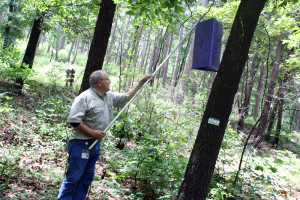A story in Time magazine last month covered the toll being exacted on American urban forests by the emerald ash borer, the latest in a string of illegal immigrant destructive insects. According to the story, the toll of dead trees will likely surpass those felled by Dutch elm disease by the end of this year, making it the most destructive forest insect ever to invade North America.

AgriLife Extension employee, Dr. Charlie Helpert, checks one of the emerald ash borer traps in an east Texas park.
So what is the threat to Texas forests? Probably not as great as that being experienced in the east-central states where ash is a common street tree, and much more common in natural landscapes. Nevertheless, the impact would likely be significant. As a result, Texas is actively monitoring for emerald ash borer with the assistance of the U.S. Department of Agriculture’s Animal and Plant Health Inspection Service (APHIS). Our lab has received funding from APHIS for the past few years to be the lookouts for this pest.
Dr. Charlie Helpert, research assistant at the Texas AgriLife Research and Extension Center, drove over 15,000 miles last summer deploying and checking the purple traps put out to collect any emerald ash borers in the neighborhood. The traps are designed, and the color selected, to be especially attractive to the beetle. Over 200 traps have been deployed throughout the eastern portions of the state, mainly in state and federal camping sites.
Camping sites have been determined to be in the vanguard of places most likely to see emerald ash borer. This is because itinerant campers who purchase or cut firewood in one state and carry it to another are one of the principal means of transporting this pest. Helpert, with the assistance of state parks and federal officials, determined those locations where the most out-of-state travelers camp. Among those sites, parks where ash trees are common are given highest priority.
The lesson here is that if you camp, don’t carry firewood from place to place. If you want to learn more about the emerald ash borer and how to be part of Texas’ early warning network, visit the ash borer pages at the Texas Invasives website.